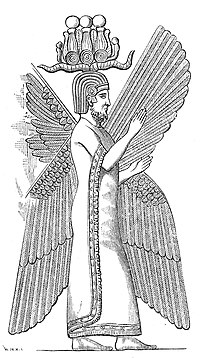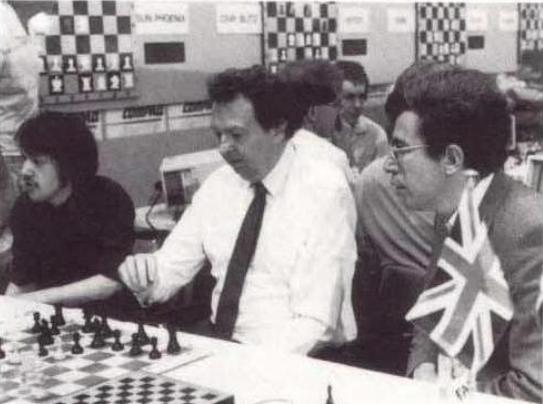Cyrus 68K
Cyrus 68K,
a chess program by Mark Taylor and advisor David Levy for the 68000 (68K) based family of microprocessors. Cyrus 68K, not to confused with Richard Lang's earlier program Cyrus, was written by Taylor from scratch in 1985. Richard Lang, like Mark Taylor affiliated with Levy's and O’Connell's company Intelligent Software, already focused on Psion at that time, had abandoned Intelligent Software, and was about to work for Hegener & Glaser on Mephisto.
Contents
Photos & Games
Mark Taylor, Kevin O’Connell and David Levy with Cyrus 68K vs. Nona, WCCC 1986 [2] [3]
[Event "5th World Computer Chess Championship"] [Site "Cologne, Germany"] [Date "1986.06.15"] [Round "5"] [White "Nona"] [Black "Cyrus 68K"] [Result "1-0"] 1.d4 e6 2.e4 d5 3.Nc3 Bb4 4.e5 Ne7 5.Bd2 Nf5 6.Nf3 Be7 7.Bd3 Nc6 8.Be3 Nxe3 9.fxe3 Nb4 10.Be2 c5 11.O-O Nc6 12.Na4 c4 13.Nc3 Kf8 14.e4 Ke8 15.Rf2 h6 16.exd5 exd5 17.Qd2 Bf5 18.Nd1 Nb4 19.Ne3 Be4 20.b3 cxb3 21.axb3 h5 22.Ng5 Bxg5 23.Qxb4 Qe7 24.Bb5+ Kf8 25.Qxe7+ Kxe7 26.Re1 Ke6 27.c4 Raf8 28.cxd5+ Bxd5 29.Nxd5 Kxd5 30.e6 Be7 31.Rxf7 Rxf7 32.exf7 Bb4 33.Rd1 Rf8 34.Be2 h4 35.Bc4+ Kd6 36.Rf1 Bc3 37.Rf4 Rh8 38.f8=Q+ 1-0
SEX
Cyrus 68K was Intelligent Software's testbed for the SEX Algorithm, to apply fractional extensions and reductions, most notably already a kind of LMR, considering forced tactical moves such as checks, captures, mate threats determined by Mate at a Glance, as well as killer moves and early non-tactical moves and from a evaluated and sorted move list with a lower depth decrement than later non-tactical siblings.
Excerpts from The SEX Algorithm in Computer Chess 1989 [4] :
Later we designed a 68000 program called Cyrus 68K, written by one of us (Mark Taylor), which evaluated and sorted all the moves from a node being expanded: we used these evaluations to determine the SXDEC for moves that were non-tactical. An obvious way to accomplish this is to assign the "best" (i.e., highest-scoring) non-tactical move a low SXDEC and to determine the SXDEC values for its non-tactical siblings on the basis of the difference in score among them. ... A second generation of the search extension algorithm was developed during the period 1985-1988. Many of the original ideas were used but we tried to eliminate certain obvious deficiencies and to make the intelligence in the program more sophisticated. We came up with a number of new ideas and tested them in a 68000-based program called Cyrus 68K. In general the results were rather encouraging, and we now feel that there is no longer a need to be shy about our work, hence the revised acronym for the algorithm and the renaming of the key variables to SEX and SEXDEC.
The Sphinx
Cyrus 68K was commercially available as the Sphinx, a dedicated chess computer under the brand name CGX, and manufactured by Eric White's Newcrest Technology Ltd., Hong Kong [5] [6].
See also
Publications
- David Levy, David Broughton, Mark Taylor (1989). The SEX Algorithm in Computer Chess. ICCA Journal, Vol. 12, No. 1, pp. 10-21
External Links
Chess Program
- Cyrus 68K' ICGA Tournaments
- The chess games of Cyrus 68K (Computer) from chessgames.com
- CXG Electronic Chess Computers from The Spacious Mind
- Chess Computers - The UK Story from Chess Computer UK by Mike Watters
Misc
- Cyrus (disambiguation) from Wikipedia
- Cyrus I from Wikipedia
- Cyrus the Great from Wikipedia
- Cyrus IMAP server from Wikipedia
References
- ↑ Illustration from "Illustrerad verldshistoria utgifven av Ernst Wallis. Volume I": Relief of Cyrus, 1875. Cyrus the Great from Wikipedia, not to confused with his grandfather Cyrus I
- ↑ Chess Computers - The UK Story from Chess Computer UK by Mike Watters
- ↑ Cologne 1986 - Chess - Round 5 - Game 7 (ICGA Tournaments)
- ↑ David Levy, David Broughton, Mark Taylor (1989). The SEX Algorithm in Computer Chess. ICCA Journal, Vol. 12, No. 1, pp. 10-21.
- ↑ CXG Electronic Chess Computers from The Spacious Mind
- ↑ CXG from Schachcomputer.info Wiki

